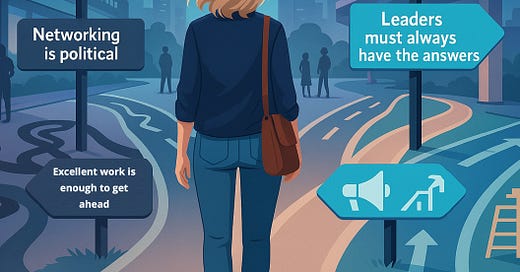Beyond “Be More Strategic”: 5 Myths Sabotaging Product People (and What to Do Instead)
How to navigate the unspoken truths that shape your PM career
Have you ever received that dreaded feedback to "be more strategic" in your product management role? That sinking feeling in your stomach, wondering what you're missing, is more common than you think.
After two decades leading product teams and coaching countless PMs, I've discovered something surprising: The issue isn't your strategic thinking abilities - it's navigating the unspoken rules that shape product leadership.
Here are five myths derailing promising product careers:
Myth 1: Only some people are strategic
Truth: We can all be strategic. The real challenge is understanding your specific context.
Before joining an organization, ask about their approach to strategy:
What is their current strategy?
Who contributes to strategic decisions?
How do people carry out strategic planning?
What prompts changes in strategy?
How do teams collaborate during strategic shifts?
Vague answers or simply "it's up to product," consider whether this is the right environment for you.
A client joined a Series B startup as a senior PM and quickly received feedback that she wasn't being strategic enough. The real issue? Three competing executive visions. By facilitating conversations to align their views, she was soon praised for strategic leadership. She didn't become more strategic. She brought needed clarity.
Myth 2: There’s one way to be an effective leader
Forget the stereotype of the loud, commanding leader. Effective leadership comes in many forms, including quiet confidence and empathy.
Instead of trying to be someone you're not, I recommend:
Be the bridge that connects different teams, focusing on helping people work efficiently together.
Embrace your authentic self. If you're a quiet, thoughtful leader who excels at listening, own that as your superpower.
I worked with a Product Director trying to emulate his extroverted CEO's style. Once he embraced his natural strengths in listening and relationship building, his team's performance soared. His CEO's feedback? "I didn't need another me. I needed someone to complement my style."
Myth 3: Getting hired is a numbers game
Forget the "apply to 50 jobs a week" approach. It leads to burnout and disappointment.
If a numeric target motivates you, I suggest a slight reframe. Instead of applying for uninspiring jobs, be strategic (remember Myth #1). Target roles that align with your passions and ensure healthy networking is part of the approach.
I recommend my clients draw three concentric circles:
In the center circle, write your name. Note your core values and strengths.
In the middle circle around the center, list all your interests, hobbies, and passions including what you enjoy doing at work.
In the outer circle, capture all the ways to explore roles that align with these interests.
Don't abandon the activities that energize you during your job search. Lean into them. One of my clients is passionate about the environment. While volunteering, they met another volunteer from a sustainability tech company. The chat led to an introduction, an interview, and a product role that matched their skills and values.
Remember: Quality over quantity. Your genuine enthusiasm for well researched opportunities will shine through in interviews. And don't forget, you're evaluating them too.
Myth 4: Doing excellent work is enough to get ahead
Excellent work is crucial, but it's not enough. You need to make your manager look good - even if they're not the most effective.
Here are approaches to better understand and work with your manager:
Identify metrics they're accountable for and show how your work ladders up. They'll champion you when your efforts contribute to their success.
Learn their strengths to speak their "language." If your boss is analytical, present data. If they're deadline-driven, emphasize timeline management.
Get to know them as a person. This can be challenging. Be curious and try to find common ground which can make future conversations easier.
Understand their motivation. Discover what brought them to the org. Was it the mission? Another person? Use that story to when you share your work.
Be concise. When sharing your accomplishments, lead with impact. Frame your work in their language while speaking with clarity, not speed..
A product manager I coached was frustrated that her innovative work wasn't recognized until she linked it to her manager's new revenue growth goals. Same work, new framing. Suddenly her manager became her biggest champion.
Myth 5: Your top priority is getting a win during your first 90 days
While early wins are important, focusing solely on them can limit your long-term success.
The product leaders who gather the most momentum also focus on connections. They expand their perspective instead of narrowing it, building a network of supporters they can call upon when facing questions or challenges.
How do you build a web across the company? Here are effective approaches:
Talk to as many people as possible during your first 30/60/90 days. Ask your boss or a colleague for two names to start with. Then ask each person for another recommendation. Soon, you'll have a strong network.
Treat small talk as an opportunity, not an obligation. Find commonalities that bridge different interests. If you like tennis and they're into fashion, talk about Serena Williams' children's clothing line, inspired by her daughters.
Use "how" and "what" questions to keep conversations flowing. Open-ended questions invite the other person to share more, providing you clues about what to ask next and creating a genuine connection.
A client's biggest "win" wasn't a new feature, but improved cross-functional communication that sped up delivery and boosted customer satisfaction. His "win" wasn't a product feature but a process improvement with a greater impact.
Bringing everything together
Reflecting on these myths, I'm struck by the pressure we put on ourselves as product leaders. We strive to be strategic in organizations that don’t have a strategy. We try to conform to leadership styles that don't match our strengths. We chase arbitrary metrics in our job searches and careers.
The path forward isn't about working harder within flawed frameworks. It's about recognizing them and creating a more authentic approach.
Being strategic isn't about having all the answers. It's about asking the right questions.
Leadership isn't about fitting a mold. It's about leveraging your unique strengths to bring out the best in others.
Success isn't about checking boxes. It's about creating meaningful impact in energizing ways.
Next time you wrestle with feedback to "be more strategic" or question your leadership approach, remember there's no single way to excel in product management. The most successful product leaders understand their context, embrace their strengths, and build meaningful connections.
What myths have you encountered in your product career, and how have you overcome them? Share your experiences in the comments.
If you're looking for more ways to build confidence and move forward in your career, I have some exciting things in motion:
Connect over LinkedIn with a note: Diana Stepner
Curious about coaching? Let’s talk.
Get notified about my Maven course on applying soft skills as a product manager.





